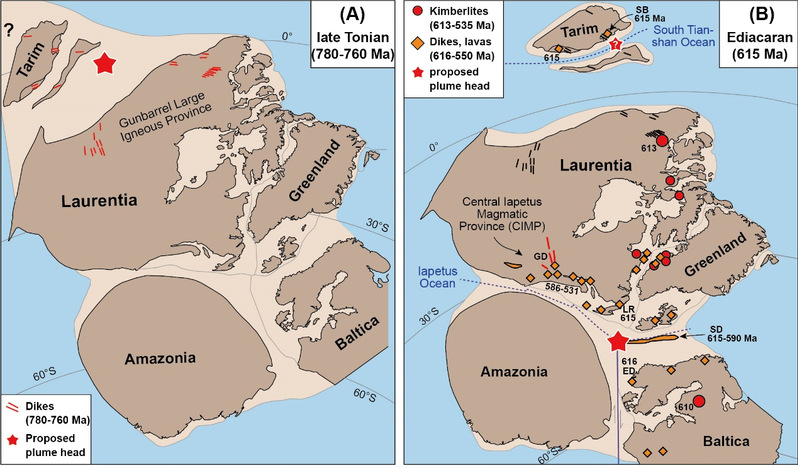Editor: 邵丹蕾 Author: Zhang Fengqi Time: 2022-05-16 Number of visits :298
The Sinian (Ediacaran) Period was the last geological stage of Precambrian history during the evolution of the Earth. During the Sinian, the breakup of the Rodinia supercontinent induced the reorganization of the plate tectonic pattern of the Earth's lithosphere, the global magmatism and large-scale mineralization, which also had a significant impact on the evolution of continental geomorphology, climate and environment. The Sinian evolution of the Rodinia thus has long been of great interest to most researchers. As one of the major cratons in China, the Tarim is an important continental entity for understanding the east and central Asian continents involving the Precambrian supercontinent evolution. However, there are different views on the tectonic process of the late Neoproterozoic rifting in the northern margin of the Tarim Craton and the development as well as its dynamics of the passive continental margin, largely constrains the understanding of paleogeographic reconstruction of Tarim in the Rodinia jigsaw.
Based on geological investigation of a typical section of Sinian System in NW Tarim margin (Fig. 1), the basin structural research team of the Zhejiang University carries out detailed petrological, geochemical and isotopic analysis for the basaltic lava flows in the Sugetbrak Formation and detrital zircon dating analysis for the sub- and epivolcanic sedimentary strata. Integrated these results, this study proposed that the northwestern margin of Tarim Craton experienced an important tectonic transition from continental rift to drift in the early Sinian. This event not only caused the eruption of the ca. 615 Ma Sugetbrak basaltic lava, but also gave rise to an abrupt basin switching from the offshore facies deposition to the platform carbonate sedimentation at the beginning of the late Sinian. Meanwhile, a vital provenance change was also recorded in these sub- and epivolcanic sedimentary strata, which witnessed the abrupt disappearance of the igneous source rocks of Qingbaikou ages (890-800 Ma) after the volcanic eruption. According to the temporal characteristics and distribution of the regional magmatic records, these early Qingbaikou-aged magmatic clasts were suggested sourced from a continental margin arc terrane (Yili-Central Tianshan) to the north rather than provided by the Tarim Craton. Geochemical and isotopic data indicated that the Sugetbrak basalts have typical ocean-island basalt (OIB) affnitty and are likely derived from partial melting of an enriched mantle source (EM I) in an intra-plate setting. The evidence points to a scenario that the northwestern margin of Tarim Craton underwent a significant tectonic transition from continental rifting to passive margin evolution in the Sinian, and the breakup of the Yili-Central Tianshan Block and the Tarim Craton gave birth to the nascent South Tianshan Ocean.

Fig. 1. (A) Sketch map of the Tarim craton and surrounding terranes in northwest China; (B) Regional geologic map of the Aksu region. (after Wu et al., 2022)

Fig. 2 Paleogeographic reconstructions of eastern Rodinia and Tarim craton with its adjacent terranes: (A) during late Tonian (780–760 Ma) and (B) in the Ediacaran (ca. 615 Ma). (after Wu et al., 2022)
In addition, the early Sinian continental flood basalt event in the northern margin of the Tarim Craton are coeval with the earliest pulse of Central Iapetus magmatic province in the eastern and northern margins of the Laurentia (North America). The continental rift-drift tectonics along the northern margin of the Tarim Craton was also simultaneous with the opening processes of the paleo-Pacific Ocean along the western Laurentia margin (Fig. 2). Especially, the widespread 780-760 Ma northwest-trending mafic dike swarms along the northern margin of the Tarim Craton matching the ca. 780 Ma Gunbarrel dike swarms on the western Laurentia suggest a potential close relationship. Compiled with the paleomagnetic data from previous studies, the north margin of the Tarim Craton and the western flank of Laurentia could form two conjugate continental margins in the late Neoproterozoic, and the ca. 780 Ma mafic dike swarm likely indicated a mantle plume center located to the west side of Laurentia( Fig.2 A), which induced the rifting along two continental margins. The early Sinian mantle plume activity was an important mechanism for the final breakup of the Tarim Craton and western Laurentia (Fig.2 B).
Hong-Xiang Wu, the first author of this paper, is a doctoral candidate at the School of Earth Sciences, Zhejiang University. Professor Feng-Qi Zhang and Professor Han-Lin Chen of Zhejiang University are the corresponding authors. This research was funded by the National Natural Science Foundation of China (Grant No. 42077223), the Basic Science Centre Program for Multiphase Media Evolution in Hypergravity of the National Natural Science Foundation of China (No. 51988101), the National Key Research and Development Program of China (grant No. 2016YFC0601004) and the National Science and Technology Major Project Fund of China (grant No. 2017ZX05008-001).
Article information: Wu H X, Dilek Y, Zhang F Q, Chen H L, Chen H, Wang C Y, Lin X B, Cheng X G. Ediacaran magmatism and rifting along the northern margin of the Tarim craton: Implications for the late Neoproterozoic Rodinia configuration and breakup[J]. GSA Bulletin, 2022, published online, DOI:10.1130/B36305.1.
